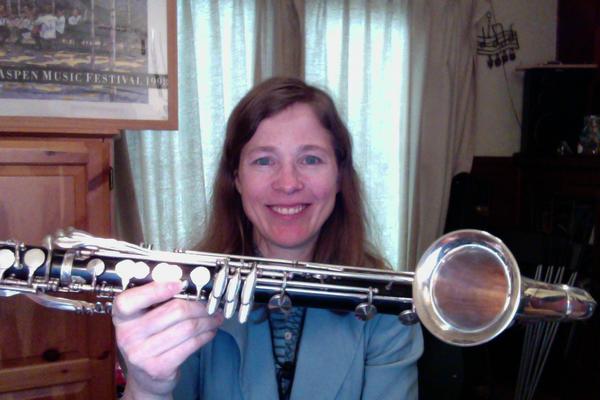|
In This Issue March 6, 2013
|
- A Note From Michelle Anderson - fun with basset horns
- Free Training - A trilling experience for you
- Clarinet Mentors Community Member Videos - get your own feedback from Michelle
- Michelle Recommends - Some great clarinet duets
- Clarinet Is Easy - Step-by-step video lessons to help you improve your clarinet playing and save you a lot of time and frustration
|
A Note from Michelle Anderson
|
Hello Everyone!
A big welcome to all of you who are reading the Clarinet Mentors newsletter for the first time. Thanks for joining the community, and I hope you find great value here for your own clarinet playing! These newsletters are sent to the Clarinet Mentors community every two weeks, usually on Wednesdays, and are designed to help you play the clarinet more easily.
I hope that all of you are enjoying your clarinet this week, whether you play mostly on your own, or if you also enjoy playing with others in lessons, bands, church groups, orchestras or small ensembles. I've been lucky enough to play with several other great musicians lately. I had a big chamber music concert last week, as well as a wind ensemble concert, and now I am full swing into rehearsals for the Magic Flute with the Vancouver Opera. It is a real treat to play Magic Flute with such a great cast of singers, and my colleagues in the Vancouver Opera Orchestra. For this performance, I get to play three numbers on the basset horn. Mozart loved the timbre of this instrument, which is bit mellower and deeper than regular clarinets. One movement is scored for basset horns, bassoons and trombones in a beautiful, serene chorale-like setting. Basset horn is tuned in the key of F, and plays with an alto clarinet mouthpiece and reed set up. If you are curious about this rarely-used instrument, I've made a very brief video to let you see and hear it in action. Just click on the photo below to access the video.
Enjoy your clarinet this week, and thanks for being a part of my community!


Free Training - Tips for Trilling
|
Trill Basics - What are they - what notes do you play?
More Advanced Trill Technic - How do our fingers move fast enough?
Many people find that trilling can be tricky on the clarinet. First of all, what do we do? In a nutshell, a trill is moving quickly between the written note, and the note that would be written one note higher. If your trill is written on a A, you would move between A and B. Notice the key signature, and follow it. If there is Bb in the key signature, then your trill is A to Bb. There are some fancy ornamentations that require you to start on the upper note, but usually, that is in music written before they invented clarinets. Most modern publications will indicate if the trill should be interpreted this way. If you are playing baroque music, often the trill starts on the upper note, but the same two notes are involved. Most of time, on clarinet, the trill will start on the written note, and move between that note and the note above it, quickly.
If the fingering is really awkward, there may be a trill fingering to assist you. These are often "fake fingerings" that can pass inspection on a high speed trill, but wouldn't sound great if you lingered on the note for very long. You can look at a trill chart that gives you some alternate fingerings.
You can, and should, experiment with some of these alternate fingerings. With some of them, you need to move your fingers really quickly to disguise the fact that the alternate fingerings may not sound so good. They are handy to know.
How do I get my fingers to move faster?
Building finger speed is always a dilemma. In the trill training video below, I show you how I build speed in trills. The key for me is to focus on hand position and lightness in my fingers. I also take the trill at a very slow speed, and imagine that I am playing sixteenth notes with my metronome. I gradually speed up the tempo, but keep my focus on arched, gentle fingers that come down with very light pressure.
Enjoy the video below, and I hope it helps you with your next trilling experience! Please add your comments and questions to the YouTube comments section below the video. I enjoy hearing from you.

Click on the image above to view this video. I have more videos currently in production. If there are topics that you would like help with, please send me some suggestions. If you are on Facebook, you can post your comments at: http://www.facebook.com/ClarinetMentors
|
Michelle Recommends - Some Great Duet books for you
|
I love playing duets. My students who come to my studio to study with me in person know that we make playing duets together a regular part of our lessons. It is a great way to work on tone, style and intonation all at once.
I have enjoyed any printed materials that Leon Lester has arranged or written. This collection of duets is an intermediate level set of very well-written duets. It is ideal for someone who has been playing for one or two years, although more advanced players would have fun playing it for some easy sight-reading.

For those of you who are more advanced, and have an advanced buddy to play with, this two-clarinet version of the Weber Grand Duo Concertant is tremendous fun. Both parts are very challenging. The first clarinet part pretty well contains the original clarinet part, but also gets to play some of the piano interludes. The second part, gets some great virtuoso playing, and also does some stuff that clarinet usually doesn't do! Fun, but challenging. This would normally be for players with at least four years of experience (maybe more...). Enjoy!
|
Clarinet Is Easy - Your Step-by-Step Beginner Course - Now Available! (Also enjoyed by many intermediate level players)
|
How To Solve Your Common Clarinet Frustrations and Play Clarinet More Easily
I firmly believe that if anyone has the "recipe" for how to play clarinet, things are really relatively easy to do. Most of our frustrations come from inadvertently learning bad habits along the way. With that in mind, I have created for you a 10 lesson course for beginners (and self-taught intermediate players) that gives you the tools to truly learn the clarinet easily, while avoiding all of the most common frustrations that can plague us. I believe that these lessons can save you hours of grief by giving you the best practise systems that have worked for hundreds of clarinetists. The lessons have great content, and are presented in a video format so that you can watch them again and again. If you would like to play with more ease and have a clear understanding of the fundamentals of clarinet playing, you can get more information on the Clarinet Is Easy course here (including some free preview videos):
If you are curious about this, you can also try the first lesson with a 100% Money-Back Guarantee. If it is not the right style for you, you get your tuition refunded, no problem.
Michelle Anderson, the founder of Clarinet Mentors, is a professional clarinetist and teacher who currently lives in Vancouver BC. Her professional career spans 30 years and she currently plays regularly with the Vancouver Opera Orchestra, the Pacific Symphonic Wind Ensemble and the West Coast Chamber Music series. She has performed with the Vancouver Symphony Orchestra, the CBC Vancouver Orchestra, the Winnipeg Symphony Orchestra, the Royal Winnipeg Ballet Touring Orchestra and many other groups. Michelle currently specializes in teaching adults to play clarinet more easily and quickly through online resources, and conducts the Vancouver Clarinet Choir.
Thanks for reading this biweekly newsletter.
|
|
Helping you to find success on your instrument with sound teaching techniques, and useful learning systems.
|
|
|





